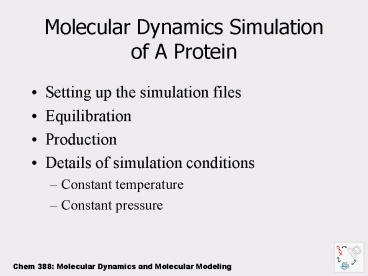Molecular Dynamics Simulation of A Protein - PowerPoint PPT Presentation
1 / 19
Title:
Molecular Dynamics Simulation of A Protein
Description:
Tinker. MMTK. Chem 388: Molecular Dynamics and Molecular Modeling. Setting Up The Simulation ... Amber parameter and topology library files. Massage the input ... – PowerPoint PPT presentation
Number of Views:475
Avg rating:3.0/5.0
Title: Molecular Dynamics Simulation of A Protein
1
Molecular Dynamics Simulation of A Protein
- Setting up the simulation files
- Equilibration
- Production
- Details of simulation conditions
- Constant temperature
- Constant pressure
2
MD Simulation Packages
- Hyperchem
- Insight, Accelrys
- Sybyl, Tripos
- PC Model
- Schrodinger
- Amber
- Charmm
- NAMD
- Gromos
- Tinker
- MMTK
3
Setting Up The Simulation
- Obtaining the structure (PDB) file
- Amber parameter and topology library files
- Massage the input file to read in Leap
- Workout the missing parameters if any
- Add solvent box
- Neutralize charge of the system with counterions
- Write the coordinate and parameter file
- Run minimization
- Heating and Equilibration dynamics
- Production dynamics
4
PDB File
5
The PDB File
6
The Biological Unit
Viral Capsid Asymmetric Unit
Viral Capsid Biological Unit
7
AMBER Parm file
8
(No Transcript)
9
Residue Topology File
10
LEaP
L Link E Edit and P Parm
11
LEaP
12
Sander Input File
13
Temperature Control
- To generate NVT, NPT ensembles
- To study the system behavior as temperature
changes - Protein unfolding
- Perform simulated annealing
- Searching conformational space
14
Constant Temperature Dynamics
- Kinetic Energy
- Velocity Reassignment Maxwell-Boltzmann
Distribution - Velocity Scaling
15
Constant Temperature Dynamics
- Berendsen Temperature Coupling Scheme
Rate of change of temperature is proportional to
the difference in temperature between bath and
the system ? a coupling parameter whose
magnitude determines how tightly the bath and
system are coupled
Amber simulation ? 0.5- 5.0 ps
- Artifact Hot solvent, sold solute
16
Constant Temperature Dynamics
- Stochastic collisions method Anderson et al.
- Randomly choose a particle and reassign its
velocities from a Maxwell-Boltzmann distribution - Trajectory Collection of mini microcanonical
simulations - Extended system method Nosé et al., Hoover et
al. - Thermal reservoir is part of the system,
represented by additional degrees of freedom - A fictitious mass parameter of the extra degree
of freedom controls energy flow between the
reservoir and system, larger the value of this
parameter, slower the energy flow
17
Constant Pressure Dynamics
- Isothermal-isobaric ensemble
- Pressure is related to virial product of
position and the derivative of PE - Pressure is maintained by volume fluctuations of
the simulation cell - Volume fluctuations is related to isothermal
compressibility, ?
18
Constant Pressure Dynamics
- Box side 20 Å (volume 8000 Å3) at 300 K
- For an ideal gas ? 1 atm-1, fluctuation 18100
Å3 - for water ? 44.75x10-6 atm-1, fluctuation 121
Å3
19
Constant Pressure Dynamics
- Weak Coupling method Berendsen
- Extended Pressure-Coupling method Anderson et
al. - Introduce an extra degree of freedom (piston)
corresponding to the volume of the box































